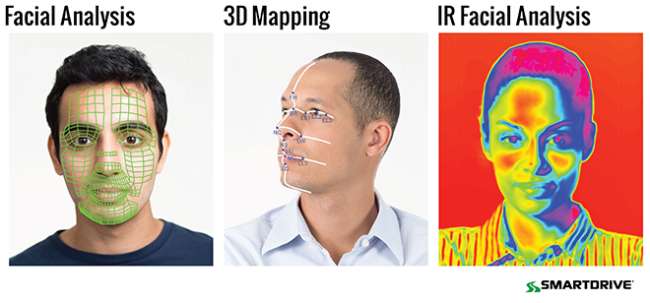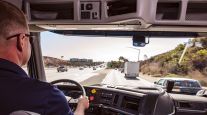SmartDrive Adds Facial Plane Analysis to Driver Monitoring System

SmartDrive Systems has ramped up the battle for market share in the growing video safety and transportation intelligence arena, introducing a new driver-assist sensor product addressing distracted driving. The San Diego tech firm also garnered an investment from Michelin North America.
SmartDrive offers fleet driver monitoring with video systems that are designed to improve safety, reduce accidents and insurance costs, and accelerate training programs.

Lytx, also out of San Diego, is the pioneer in the segment, and claims a two-thirds market share in the systems where as many as a 10 cameras are installed on and around a truck and its trailer and in the cab.
In October, SmartDrive launched its SmartSense suite of driver-assist sensors designed to identify and capture risky driving behavior. The first product, SmartSense for Distracted Driving, puts a camera on a truck’s dashboard pointed at the driver to watch for texting, drowsiness, inattentive driving and eyes-off-road.
Distracted driving accounts for 10% of all fatal crashes and 17% of collisions that cause crashes, according to SmartDrive.
The SmartSense product adds a new wrinkle to monitoring, using an infrared sensor that tracks facial planes and movement to indicate distraction. The sensor can capture these problems even when the driver is wearing sunglasses, according to the firm.
The video begins recording once it detects any of the distraction cues, and an in-cab alert system sends out an audio alarm to the driver.
Telematics industry analyst Clem Driscoll said the checking of facial planes and eye movement is offered by Australian firm Seeing Machines, though it’s not clear if the technology has caught on.
“It’s a new form of behavior monitoring for safety. It’s an interesting solution,” said Driscoll, president of C.J. Driscoll & Associates.
(Monitoring facial planes is not a biometric system where a camera seeks to identify someone by looking for characteristics unique to a person, like the iris of the eye.)
Distracted drivers drift out of lanes 91% more than other drivers? Read more scary statistics https://t.co/CfsFGjUxkv #trucking pic.twitter.com/suEn5qkYue — SmartDrive Systems (@SmartDriveInc) November 2, 2017
SmartSense for Distracted Driving will be available in January 2018. It was introduced at the American Trucking Associations’ annual Management Conference & Exhibition in Orlando in October.
The driver monitoring systems initially received pushback from drivers who claimed the concept smacked of Big Brother watching them.
But the systems are proving in many cases to be driver-friendly, confirming the operator’s side of the story when a consumer claims his car was hit or sideswiped by a truck, a client wasn’t available for scheduled offloading, or a driving complaint proved to be a load of bologna. Cargo theft and truck tampering has also been caught.
Fleets have been installing the systems to cut accidents and incidents and that can have the added benefit of reducing insurance costs. The in-cab cameras play upon a basic human characteristic — drivers who know they are being recorded tend to stay on their best behavior.
Lytx, the pioneer in video-based driver safety programs, reports that clients have cut their U.S. Department of Transportation reportable accidents by nearly 70% and reduced by 60% their dollars reserved for claims.
The video records also provide fleet managers with good training tools for new drivers and refresher instruction for experienced operators.
The other big news in October from privately held SmartDrive was a Michelin North America led preferred-stock round of investment in the company, though the value of the funding wasn’t disclosed.
SmartDrive has received more than $180 million in seven funding rounds since its 2004 founding, according to Crunchbase. Major funders include New Enterprise Associates, Oak Investment Partners and Wabco, the global supplier of safety systems for commercial vehicles.
Lytx remains the big dog among the firms offering driver monitoring. It was founded in 1998 but was purchased by private equity investor GTCR for more than $500 million last year. Lytx claims it has more than 2,200 clients and that it protects more than 650,000 drivers.
Other competitors in the driver monitoring arena include Houston-based Safety Vision and Australia’s Seeing Machines.


